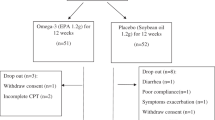Abstract
Inattention, hyperactivity and impulsivity constitute the core diagnostic criteria for attention deficit hyperactivity disorder (ADHD) children. Patients generally suffer from sleep disturbance and malnutrition that can account for tiredness during the day, poor concentration, poor eating and depressed mood, along with anemia and an n-3 polyunsaturated acid deficiency. The change of ADHD behavior in children (9–12) was studied, following 10 weeks of treatment with a polyunsaturated acid mixture on six variables: cooperation, mood, concentration, homework preparation, fatigue and sleep quality. Iron status was also examined. Polyunsaturated acid administration was associated with significant improvement in quality of life, ability to concentrate, sleep quality and hemoglobin levels.
This is a preview of subscription content, access via your institution
Access options
Subscribe to this journal
Receive 12 print issues and online access
$259.00 per year
only $21.58 per issue
Buy this article
- Purchase on Springer Link
- Instant access to full article PDF
Prices may be subject to local taxes which are calculated during checkout
Similar content being viewed by others
References
Burgess JR, Stevens L, Zhang W, Peck L (2000). Long-chain polyunsaturated fatty acids in children with attention-deficit hyperactivity disorder. Am J Clin Nutr 71, 327S–330S.
Farooqui AA, Horrocks LA (2001). Plasmalogens, phospholipase A2, and docosahexaenoic acid turnover in brain tissue. J Mol Neurosci 16, 263–272.
Kidd PM (2000). Attention deficit/hyperactivity disorder (ADHD) in children: rationale for its integrative management. Altern Med Rev 5, 402–428.
Owens JA (2009). A clinical overview of sleep and attention-deficit/hyperactivity disorder in children and adolescents. J Can Acad Child Adolesc Psychiatry 18, 92–102.
Richardson AJ, Puri BK (2000). The potential role of fatty acids in attention-deficit/hyperactivity disorder. Prostaglandins Leukot Essent Fatty Acids 63, 79–87.
Raz R, Carasso RL, Yehuda S (2009a). The influence of short-chain essential fatty acids on children with attention-deficit/hyperactivity disorder: a double-blind placebo-controlled study. J Child Adolesc Psychopharmacol 19, 167–177.
Raz R, Gabis L (2009). Essential fatty acids and attention-deficit-hyperactivity disorder: a systematic review. Dev Med Child Neurol 51, 580–592.
Ross BM, McKenzie I, Bennett CP (2003). Increased levels of ethane, a non-invasive marker of n-3 fatty acid oxidation, in breath of children with attention deficit hyperactivity disorder. Nutr Neurosc 6, 277–381.
Sever Y, Ashkenazi A, Tyano S, Weizman A (1997). Iron treatment in children with attention deficit hyperactivity disorder. A preliminary report. Neuropsychobio 35, 178–180.
Sobanski E, Schredl M, Kettler N, Alm B (2008). Sleep in adults with attention deficit hyperactivity disorder (ADHD) before and during treatment with methylphenidate: a controlled polysomnographic study. SLEEP 31, 375–381.
Stevens LJ, Zebtall SS, Deck JL, Abate ML, Watkins BA, Lipp SR et al. (1995). Essential fatty acid metabolism in boys with attention-deficit hyperactivity disorder. Am J Clin Nutr 62, 761–768.
Yehuda S (2003). Omega-6/omega-3 ratio and brain-related functions. World Rev Nutr Diet 92, 37–56.
Yehuda S, Rabinovitz S, Carasso RL, Mostofsky DI (2007). Pretreatment with a mixture of essential fatty acids protects rats from anxiogenic effects of REM deprivation. Nutr Neurosci 10, 269–271.
Yehuda S, Rabinovitz S, Mostofsky DI (1999). Essential fatty acids are mediators of brain biochemistry and cognitive functions. J Neurosci Res 56, 565–570.
Acknowledgements
We thank The Rose K Ginsburg Chair for Research into Alzheimer's disease and The William Farber Center for Alzheimer Research for their support.
Author information
Authors and Affiliations
Corresponding author
Ethics declarations
Competing interests
The authors declare no conflict of interest.
Rights and permissions
About this article
Cite this article
Yehuda, S., Rabinovitz-Shenkar, S. & Carasso, R. Effects of essential fatty acids in iron deficient and sleep-disturbed attention deficit hyperactivity disorder (ADHD) children. Eur J Clin Nutr 65, 1167–1169 (2011). https://doi.org/10.1038/ejcn.2011.80
Received:
Revised:
Accepted:
Published:
Issue Date:
DOI: https://doi.org/10.1038/ejcn.2011.80
Keywords
This article is cited by
-
Maternal Sleep in Pregnancy and Postpartum Part II: Biomechanisms and Intervention Strategies
Current Psychiatry Reports (2019)
-
Anti-Oxidative Effects of Melatonin Receptor Agonist and Omega-3 Polyunsaturated Fatty Acids in Neuronal SH-SY5Y Cells: Deciphering Synergic Effects on Anti-Depressant Mechanisms
Molecular Neurobiology (2018)
-
Fatty acids rehabilitated long-term neurodegenerative: like symptoms in olfactory bulbectomized rats
Journal of Neural Transmission (2015)
-
Biometals and Their Therapeutic Implications in Alzheimer's Disease
Neurotherapeutics (2015)


